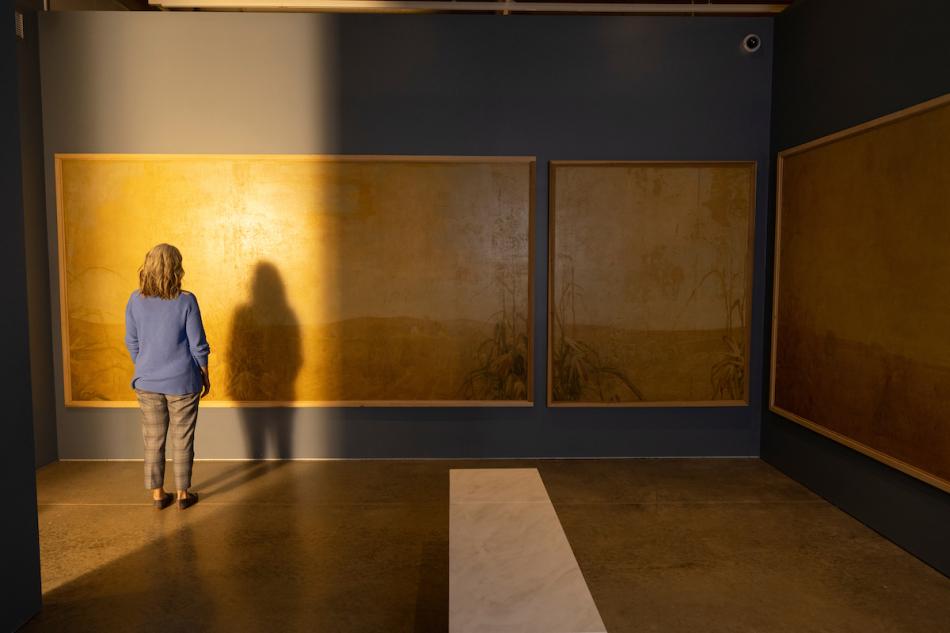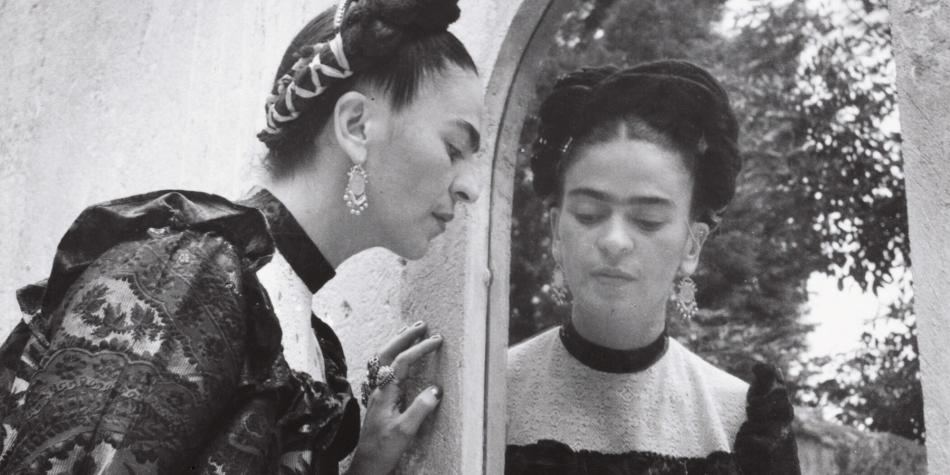New Road
1939
Grant Wood
Painter, American, 1891 - 1942

The Iowa artist Grant Wood was one of the leading midwestern American regionalist painters. Created in 1939 after a three-year period in which Wood concentrated on lithography, New Road and its companion Haying are representative examples of the idealized rural landscapes that the artist had begun to paint in 1930. Such works, rendered in a detailed, deliberately naïve style, typically include the cultivated lands, farms, manual farm machinery, windmills, and domestic animals characteristic of Iowa. New Road depicts a landscape on the route between Cedar Rapids and Lake Macbride. A rustic sign at the upper right inscribed “SOLON 5 MI” indicates that the gravel lane leads to Solon, a small city in Johnson County in eastern Iowa just south of Cedar Rapids. The intersection at the center of the composition echoes the cruciform pattern of the signpost. The dramatic vantage point looking directly down the steeply descending pathway imbues the bucolic scene with a sense of excitement. Landscapes such as New Road serve as both optimistic celebrations of better times to come and subtle portrayals of the state of American life as it turned from the calamities of the 1930s to the even more ominous, existential challenges of World War II. Suspended in time and poised at a particularly fraught moment in the history of the country, they are replete with the ambiguities and subtle ironies that underlay Wood’s seemingly benign, straightforward regionalist vision.
Artwork overview
-
Medium
oil on canvas on paperboard mounted on hardboard
-
Credit Line
-
Dimensions
overall: 33 x 37.9 cm (13 x 14 15/16 in.)
framed: 53.3 x 58.4 x 3.2 cm (21 x 23 x 1 1/4 in.) -
Accession Number
1982.7.2
More About this Artwork

An installation view of Grant Wood's Corn Room (1926) at the Sioux City Art Center, Permanent Collection, 2007.17, Gift of Alan Fredregill
An installation view of Grant Wood's Corn Room (1926) at the Sioux City Art Center, Permanent Collection, 2007.17, Gift of Alan Fredregill
Article: Iowa Artists Craft Complex Visions of the Rural
How artists based in Iowa, from the early 20th century to today, have crafted their own visions of the region.

Article: 15 LGBTQ+ Artists to Know
Discover the lives of 15 LGBTQ+ artists and their art, much of which you can see at the National Gallery.
Artwork history & notes
Provenance
The artist; sold to Irwin [1880-1953] and Clara R. Sax [1889-1981] Strasburger, White Plains, New York, by 1944;[1] bequest 1982 to NGA.
[1] Darrell Garwood, Artist in Iowa: A Life of Grant Wood, New York, 1944: 222, 254.
Associated Names
Exhibition History
1939
Fine Arts Festival, Memorial Union, University of Iowa, Cedar Rapids, 1939.
1981
John Steuart Curry and Grant Wood: A Portrait of Rural America, Cedar Rapids Art Center; Edwin A. Ulrich Museum of Art, Wichita State University; Museum of Art and Archaeology, University of Missouri-Columbia, 1981, no. 148.
1985
America in Transition: Benton and His Contemporaries, 1920-1940, Williams College Museum of Art, Williamstown, Massachusetts, 1985.
1987
Extended loan for use by Vice President and Mrs. George Bush, Vice President's House, Washington, D.C., 1987-1989.
1990
Loan to display with permanent collection, Cedar Rapids Museum of Art, 1990-1991.
1991
One-Hundredth Birthday Anniversary Celebration, Cedar Rapids Museum of Art, 1991.
1994
Barn Again, National Building Museum, Washington, D.C., 1994, no catalogue.
1995
Grant Wood: An American Master Revealed, Joslyn Art Museum, Omaha, Nebraska; Davenport Museum of Art, Iowa; Worcester Art Museum, Massachusetts, 1995-1996, no. 55, pl. 9.
2000
Illusions of Eden: Visions of the American Heartland, Columbus Mus. of Art; Palais Liechtenstein, Vienna; Ludwig Mus., Budapest; Madison Art Center; Wash. Pavilion of Arts and Sciences, Sioux Falls, 2000-2001, no. 9, repro. (shown only in Columbus).
2008
Walt Disneys wunderbare Welt und ihre Wurzeln in der europäischen Kunst [Disney's Wonderful World and its Roots in European Art], Kunsthalle der Hypo-Kulturstiftung, Munich; Helsinki Art Museum, 2008-2009, no. 90, repro.
2016
Grant Wood and the American Farm, Reynolda House Museum of American Art, Winston-Salem, 2016, no catalogue.
2018
Grant Wood: American Gothic and Other Fables, Whitney Museum of American Art, New York, 2018, no. 95, repro.
Bibliography
1971
Garwood, Darrell. Artist in Iowa: A Life of Grant Wood. (New York, 1944) Reprint Westport, CT, 1971: 222.
1975
Dennis, James M. Grant Wood: A Study in American Art and Culture. New York, 1975: 93-94, 159, color pl. 36.
1981
Czestochowski, Joseph S. John Steuart Curry and Grant Wood: A Portrait of Rural America. Columbia, MO, 1981: fig. 148.
1988
Wilmerding, John. American Masterpieces from the National Gallery of Art. Rev. ed. National Gallery of Art, Washington, D.C., 1988: 182, repro.
1992
American Paintings: An Illustrated Catalogue. National Gallery of Art, Washington, 1992: 384, repro.
1995
Roberts, Brady M., James M. Dennis et al. Grant Wood: An American Artist Revealed. Exh. cat. Joslyn Art Museum, Omaha, NE; Davenport Museum of Art, IA, and the Worcester Art Museum, MA, 1995-1996. Davenport and San Francisco, 1995: 3, 73, color pl. 10.
2000
Stearns, Robert, et al. Illusions of Eden: Visions of the American Heartland. Exh. cat. Columbus Museum of Art, OH, 2000: no. 9, fig. 9.
2018
Haskell, Barbara, and Glenn Adamson. Grant Wood: American Gothic and Other Fables. Exh. cat. Whitney Museum of American Art, New York, 2018: 30, color pl. 95.
Inscriptions
lower left: c GRANT WOOD 1939
Wikidata ID
Q20193228



